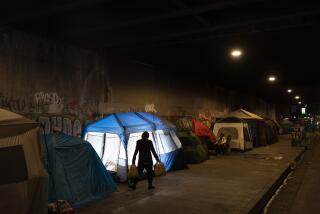NBC’s ‘227’ Sitcom Hits the Streets, Hires Homeless to Play Themselves
- Share via
Steve Salas left his job as an extra on an episode of NBC’s “227” about homelessness just in time to get some sleep--in the Cameo movie theater downtown.
Don Beckemeyer, who like Salas played a homeless man on the program, couldn’t afford such luxury. He’d used part of the $3 that the producers gave him for transportation that day to buy cigarettes, so he couldn’t afford the theater’s admission. Instead, he spent Monday night after the taping walking the streets, explaining later that it’s safer to walk them at night than to sleep on them.
Beckemeyer and Salas were among 10 homeless men and women who had bit parts on an episode of “227” that taped Monday and Tuesday this week, hired as part of a campaign by the sitcom’s star, Marla Gibbs, to bring attention to their plight. The episode, “No Place Like Home,” which was co-written by Gibbs, will air at an as-yet-undecided date later this season.
“I wanted to use the homeless people in the show so people could see them as human beings, and (know they were) not just actors,” Gibbs said in an interview.
She said she got the idea for the program after watching a television news broadcast last winter that showed the frozen bodies of homeless people in another city being picked up by sanitation workers.
In the “227” story, Gibbs’ character of housewife Mary Jenkins undergoes a Scrooge-like transformation in her attitude toward the homeless after a dream sequence shows her what it’s like to be on the street. She winds up meeting with Los Angeles homeless advocate Ted Hayes, who plays himself, and encouraging her husband, played by Hal Williams, to hire several homeless men for jobs at his construction company.
But in interviews and discussions among themselves in the bare back room at Columbia Pictures’ Sunset-Gower Studios, where they waited between takes Tuesday, they talked about the differences between their lives as seen on television and the real thing.
They described a Los Angeles where intersections aren’t known as “First and Main,” for example, but “Rock Corner”--where you go to buy cocaine--or “Thieves Corner”--”where everybody picks up different things and sells things.”
“They can’t really show it all on television,” Beckemeyer said. “There’s no way to show everything that happens out there.”
Gibbs, executive producer Irma Kalish and the others behind the “227” episode did their best to show how difficult life is among the homeless, Beckemeyer said, but much of what goes on “out there” just can’t be shown.
“People don’t want to see winos drinking lying down,” Salas agreed.
“Or the winos sitting there in front of you while you’re eating a meal and (urinating) on themselves,” Beckemeyer said. “Or someone throwing up in their food and then trying to eat it again.”
The program doesn’t show the Plasma Centers, known on the street as places to make money.
“You sit there for three hours with a needle in your arm, but you can get eight bucks for it,” Beckemeyer said. “They take out your blood and then they remove the plasma and give you back your red blood cells. You can go every other day.”
Alfredo Cortez, sitting next to Beckemeyer, added: “And those needles are really big.”
Beckemeyer nodded passionate agreement. He shoved up his sleeve to show two scabs in the crook of his arm.
Homeless since he lost his job as an oil field worker in Texas, Beckemeyer said that he goes to the plasma center every Monday and Wednesday. He has a buddy who goes those two days plus Fridays, and the pair split the proceeds from that day because “you have to stick together on the street.”
One of the best parts of the “227” job, they agreed, was the opportunity to take showers at the studio. Besides the soap and water--which left the homeless extras looking very comfortable and pleased--the company also managed unwittingly to provide a chuckle. “They get us all clean and then they put us in our ‘homeless’ costumes,” Cortez said with a smile.
In reality, they said, the wait for a shower at any of the local rescue missions can be several hours long, and includes a serious possibility that the bather’s meager belongings--including clothing--will be stolen while he or she is washing.
The jobs on “227” were arranged by homeless advocate Hayes, who said he voluntarily became homeless as part of his political commitment to their cause. Seven of the 10 extras--including Cortez, Beckemeyer and Salas--made $106 per day for their appearances, and three who were given dialogue to speak made an undisclosed amount more.
Gibbs said that she hopes the jobs will lead to more work for the homeless in Hollywood.
“Now that they did (the show), I’m hoping they can join the (Screen Extras Guild) union and some of the extra casting people will pick them up when they need people,” she said.
Beckemeyer said he plans to pool his salary with a friend’s relief check next month to try to get a cheap apartment. Hayes is sending his to his wife and kids in Riverside.
Working on the show “gives me the opportunity to make some money, to try to get shelter, a place where I can stay clean,” Salas said.
But life in the business world brought one nasty surprise for these people, who are used to odd jobs and transactions such as plasma sales that pay cash--and pay on the spot.
Columbia won’t have checks for them before a week or two, at the end of their regular pay cycle. And then there’s the problem of cashing the checks: They will have to have an identification card, and at commercial check cashing centers, it can cost as much as 20% of the check’s value to get it cashed.
“I thought we’d get paid at the end of the day,” said Salas, who on Tuesday was preparing for another night at the Cameo.
“But it’s all right,” he said. “You get to see a lot of movies.”
More to Read
Sign up for Essential California
The most important California stories and recommendations in your inbox every morning.
You may occasionally receive promotional content from the Los Angeles Times.






